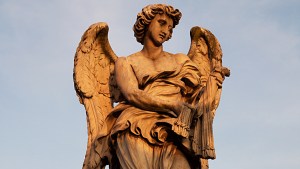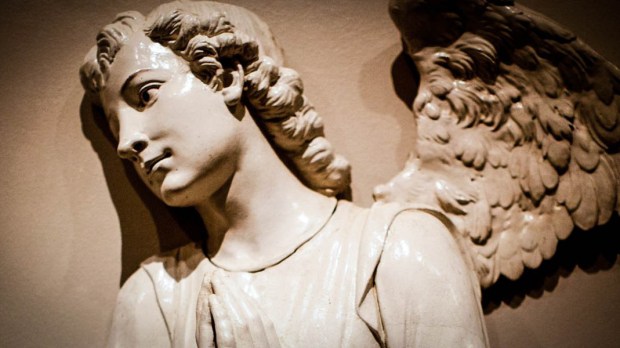Angels are not easy to depict in art as they are purely spiritual creatures. They do not posses a physical body, though at times they take on the appearance of a human.
In the Bible angels are usually described with a visible body, but that is only a facade, a mask they put on so that we can see them with our eyes. Otherwise they are naturally invisible creatures to our human eyes.
Consequently artists can depict angels in various ways, and often choose an appearance that will highlight a spiritual attribute angels possess. For example, in the fourth century, angels were painted or sculpted with wings, focusing on their missionary character.

Read more:
Do angels have wings?
During the Renaissance, artists started painting angels as children with wings. These are called putti in Italian and are a remnant of classical art, a feature of ancient Greek and Roman mythology. They were closely associated with the god Eros (Cupid), but took on a new meaning with Christianity.
Artists decided to use these putti to represent angelic creatures, typically in the background of paintings and sculptures. The spiritual significance of their babyish features was to highlight the innocence of angels. Angels were created by God with an intellect superior to human intelligence, and free will. Those that chose to stay in the courts of heaven did so definitively and remain pure in all things. This purity was translated into art through the use of beautiful chubby children.
Angels have also been depicted as fierce warriors with swords and shields, ready to do battle. This was especially true for St. Michael the Archangel, who is usually represented as a warrior dealing a death blow to Satan.
Warrior angels are very common in Scripture. Joshua meets such an angel while encamped outside Jericho.
While Joshua was near Jericho, he raised his eyes and saw one who stood facing him, drawn sword in hand. Joshua went up to him and asked, “Are you one of us or one of our enemies?” He replied, “Neither. I am the commander of the army of the Lord: now I have come.” (Joshua 5:13-14)
This visual representation highlights the reality that angels have the power to defeat spiritual enemies such as demons. Angels are powerful spiritual warriors and while their battles are largely invisible, the effects of their protection can often be felt.
However an angel is depicted, the artist is focusing on a particular aspect of their nature. While cute little babies may appear to be the opposite of fierce warriors, both representations reflect a truth about angels.

Read more:
Angels in sacred art: Making the invisible visible

